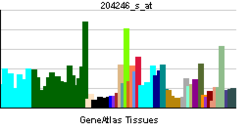- DCTN3
-
Dynactin 3 (p22) Identifiers Symbols DCTN3; DCTN-22; DCTN22; MGC111190 External IDs OMIM: 607387 MGI: 1859251 HomoloGene: 5233 GeneCards: DCTN3 Gene Gene Ontology Molecular function • structural molecule activity
• protein bindingCellular component • condensed chromosome kinetochore
• chromosome
• cytoplasm
• centrosome
• spindle
• cytosol
• cytoskeleton
• dynactin complex
• midbody
• cleavage furrow
• perinuclear region of cytoplasmBiological process • G2/M transition of mitotic cell cycle
• mitotic cell cycle
• cytokinesis
• microtubule-based process
• mitosisSources: Amigo / QuickGO RNA expression pattern 
More reference expression data Orthologs Species Human Mouse Entrez 11258 53598 Ensembl ENSG00000137100 ENSMUSG00000028447 UniProt O75935 Q9Z0Y1 RefSeq (mRNA) NM_007234.3 NM_016890 RefSeq (protein) NP_009165.1 NP_058586 Location (UCSC) Chr 9:
34.61 – 34.62 MbChr 4:
41.66 – 41.67 MbPubMed search [1] [2] Dynactin subunit 3 is a protein that in humans is encoded by the DCTN3 gene.[1][2][3]
This gene encodes the smallest subunit of dynactin, a macromolecular complex consisting of 10 subunits ranging in size from 22 to 150 kD. Dynactin binds to both microtubules and cytoplasmic dynein. It is involved in a diverse array of cellular functions, including ER-to-Golgi transport, the centripetal movement of lysosomes and endosomes, spindle formation, cytokinesis, chromosome movement, nuclear positioning, and axonogenesis. This subunit, like most other dynactin subunits, exists only as a part of the dynactin complex. It is primarily an alpha-helical protein with very little coiled coil, and binds directly to the largest subunit (p150) of dynactin. Alternative splicing of this gene generates 2 transcript variants.[3]
References
- ^ Karki S, LaMonte B, Holzbaur EL (Sep 1998). "Characterization of the p22 subunit of dynactin reveals the localization of cytoplasmic dynein and dynactin to the midbody of dividing cells". J Cell Biol 142 (4): 1023–34. doi:10.1083/jcb.142.4.1023. PMC 2132867. PMID 9722614. http://www.pubmedcentral.nih.gov/articlerender.fcgi?tool=pmcentrez&artid=2132867.
- ^ Mills DR, Jackson CL (Apr 2001). "Assignment of p22 dynactin light chain (DCTN3) to human chromosome region 9p13 by radiation hybrid mapping". Cytogenet Cell Genet 92 (1-2): 166. doi:10.1159/000056892. PMID 11306820.
- ^ a b "Entrez Gene: DCTN3 dynactin 3 (p22)". http://www.ncbi.nlm.nih.gov/sites/entrez?Db=gene&Cmd=ShowDetailView&TermToSearch=11258.
Further reading
- Karki S, Tokito MK, Holzbaur EL (2000). "A dynactin subunit with a highly conserved cysteine-rich motif interacts directly with Arp1.". J. Biol. Chem. 275 (7): 4834–9. doi:10.1074/jbc.275.7.4834. PMID 10671518.
- Strausberg RL, Feingold EA, Grouse LH, et al. (2003). "Generation and initial analysis of more than 15,000 full-length human and mouse cDNA sequences.". Proc. Natl. Acad. Sci. U.S.A. 99 (26): 16899–903. doi:10.1073/pnas.242603899. PMC 139241. PMID 12477932. http://www.pubmedcentral.nih.gov/articlerender.fcgi?tool=pmcentrez&artid=139241.
- Lehner B, Semple JI, Brown SE, et al. (2004). "Analysis of a high-throughput yeast two-hybrid system and its use to predict the function of intracellular proteins encoded within the human MHC class III region.". Genomics 83 (1): 153–67. doi:10.1016/S0888-7543(03)00235-0. PMID 14667819.
- Ota T, Suzuki Y, Nishikawa T, et al. (2004). "Complete sequencing and characterization of 21,243 full-length human cDNAs.". Nat. Genet. 36 (1): 40–5. doi:10.1038/ng1285. PMID 14702039.
- Humphray SJ, Oliver K, Hunt AR, et al. (2004). "DNA sequence and analysis of human chromosome 9.". Nature 429 (6990): 369–74. doi:10.1038/nature02465. PMC 2734081. PMID 15164053. http://www.pubmedcentral.nih.gov/articlerender.fcgi?tool=pmcentrez&artid=2734081.
- Gerhard DS, Wagner L, Feingold EA, et al. (2004). "The status, quality, and expansion of the NIH full-length cDNA project: the Mammalian Gene Collection (MGC).". Genome Res. 14 (10B): 2121–7. doi:10.1101/gr.2596504. PMC 528928. PMID 15489334. http://www.pubmedcentral.nih.gov/articlerender.fcgi?tool=pmcentrez&artid=528928.
- Rual JF, Venkatesan K, Hao T, et al. (2005). "Towards a proteome-scale map of the human protein-protein interaction network.". Nature 437 (7062): 1173–8. doi:10.1038/nature04209. PMID 16189514.
- Lim J, Hao T, Shaw C, et al. (2006). "A protein-protein interaction network for human inherited ataxias and disorders of Purkinje cell degeneration.". Cell 125 (4): 801–14. doi:10.1016/j.cell.2006.03.032. PMID 16713569.
Categories:- Human proteins
- Chromosome 9 gene stubs
Wikimedia Foundation. 2010.
